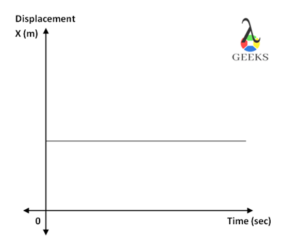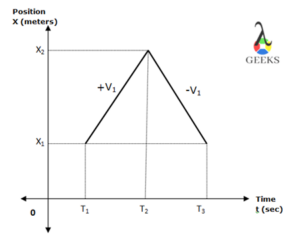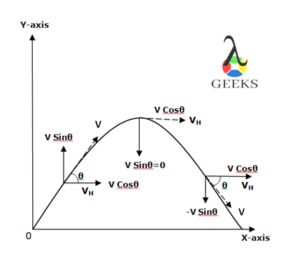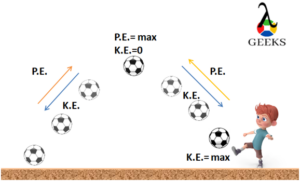In this article, we will talk about zero velocity, is velocity zero at the highest point, reason, and various facts.
The object accelerates in the upward direction with kinetic energy, its kinetic energy is converted into potential energy and has the highest potential energy once nil kinetic energy remains with the object and thus the velocity of the object becomes zero.
What is zero velocity?
The velocity is the rate of a shift in the position in a given time.
The velocity of the object is zero if the object tends to remain fixed at one position during a certain time or an object returns back to its initial position after displacement.
Position-Time Graph for Zero Velocity
On the position-time graph, the velocity of the object is zero if the slope of a graph is parallel to the x-axis.
The following graph explains the same.

The above graph shows at the position of the object remain unchanged all the time. Hence the velocity of the object is zero.
It is also true when the object returns back to the position from where it had started its journey. It is clearly indicated in the below graph.

The above graph shows that the object was displaced from x1 to x2, but then returns back to x1 after a certain time duration. Hence, the change in a position now becomes zero and therefore the velocity is also equal to zero.
Read more on Zero Velocity: What, How, When, Examples And Problems.
Why is Velocity Zero at the Highest Point?
As the object goes higher and higher above the ground surface, it stores the energy in the form of potential energy.
Once all the kinetic energy of the object is converted into the potential energy, the object does not accelerate further but is held there for a few seconds until exerts a force due to gravity which pulls the object towards itself.
The object then returns down towards the ground on converting the potential energy that it has gained into kinetic energy.
Zero Horizontal Velocity of an Object in a projectile motion
An object in a projectile motion moves in two dimensions, x-direction and y-direction.

Initially, when the object starts its journey from its origin, we have both horizontal velocity as well as vertical velocity. Once it attains the highest point where all of its kinetic energy is converted into the potential energy it stops accelerating for a while and continues to move in the horizontal direction rather than the vertical route, and then due to gravity accelerates down.
What happens to the object when its velocity becomes zero at the highest point?
The object is held at rest for the smallest duration of time when its velocity becomes zero.
When the object reaches the highest point in its flight, the kinetic energy of the object becomes zero and has the highest potential energy that it can have.
The variation of the energy of the object is shown in the below diagram.

It is seen that the ball has the maximum kinetic energy on kicking which goes on decreasing as the ball attains height. The decreasing kinetic energy is converted into the potential energy and is the maximum when the ball reaches the highest point.
The velocity of the ball is the maximum during its initial flight.
At the highest point K.E. =0; that is
1/2mv2=0
Since mass is conserved, it is evident that the velocity of the object is zero at this point.
v2=0
The energy of the object is conserved during its flight. The initial kinetic energy is converted to potential energy until the kinetic energy of the object has vanished, and then the potential energy is converted into kinetic energy.
The velocity of the object in a flight above the surface due to gravity is
When the ball has the maximum potential energy it tends to occupy the space at its highest point once all its kinetic energy is converted into potential energy. It is only because the gravitational pull of the Earth exerted on the object, pulls the object down to the surface. Hence, the object observes the freefall and accelerates downward.
Problem1: Calculate the kinetic energy and the potential energy of the object of mass 5 kg hanging above the ground at a height of 100 meters.
Solution: The height of the object from the ground is h=100m.
The mass of the object m=5kg
The potential energy of the object is given by the equation
V=mgh
=5kg x 9.8m/s2 x100=4900
=4.9k Joules
The potential energy associated with the object is 4.9kJoules.
The velocity of the objectis zero. Hence, the kinetic energy of the object is
K.E.=1/2mv2=1/2m x 0=0
The kinetic energy of the object is zero.
Problem 2: Consider the same object tied at a height of 100 meters from above the ground that is slightly drifted by the high wind speed. Find the change in potential energy of the object if it displaces its position 10cm in 2 seconds.
Given: Displacement x=10 cms=0.10m, time t=2 seconds
v= Δx/Δt = 0.1/2 = 0.05m/s
The kinetic energy of the object now is
K.E.= 1/2mv2= 1/2 x 5 x (0.05)2
=1/2 x 5 x 0.0025=0.00625 Joules
The potential energy of the object at a height of 100 meters was 4.9kJoules.
When the object sets into motion, the potential energy of the object is converted into kinetic energy.
Thus the potential energy associated with the object after the object displaces 10cm from the above height will be
P.E. = P.E.initial – K.E. = (4.9k-0.00625)J = 4.89k Joules
Read more on the Potential Energy.
Frequently Asked Questions
Is the velocity of the object falling down from the height is negative?
The velocity of the object due to gravity varying with height is given by the formula
As the difference between the final and the initial height becomes negative due to decreasing height, the velocity of the object falling down is negative.
Is the momentum of the object at the highest point conserved?
The object has momentum associated with it when it is moving with a velocity.
When the object is at the highest point above the surface, the object has no kinetic energy associated with it as the velocity of the object is zero; hence the momentum of the object is also zero.
What is a free fall?
The object after attaining the highest point in its flight and gaining the highest potential energy tends to return back to the surface.
The rapid fall and free movement of the object due to the effect of the gravitational force exerted by the Earth is called the free fall of the object.
Why acceleration of the object at the highest point is zero?
The acceleration will be zero if there is no variation in the velocity of the object.
At the highest point, the object has no kinetic energy where all of its kinetic energy is converted into the potential energy, and therefore the velocity is zero and the object does not accelerate.
Also Read:
- Horizontal speed vs horizontal velocity
- How to find constant velocity
- Instantaneous velocity vs velocity
- Position vs velocity vs acceleration
- How to determine velocity in condensed matter physics
- How to find horizontal velocity of a projectile
- How to find velocity on a graph
- How to find velocity in galactic rotation curves
- How to find velocity vector
- How to determine velocity in mechanical waves
Hi, I’m Akshita Mapari. I have done M.Sc. in Physics. I have worked on projects like Numerical modeling of winds and waves during cyclone, Physics of toys and mechanized thrill machines in amusement park based on Classical Mechanics. I have pursued a course on Arduino and have accomplished some mini projects on Arduino UNO. I always like to explore new zones in the field of science. I personally believe that learning is more enthusiastic when learnt with creativity. Apart from this, I like to read, travel, strumming on guitar, identifying rocks and strata, photography and playing chess.